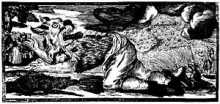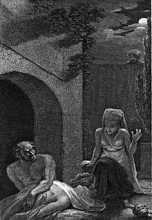The Evolutionary Psychology of Lycanthropy
That is assuming, of course, that silver is or ever was an effective weapon against werewolves. The evidence for this is surprisingly scanty. Medieval Danish people believed that the most effective treatment for lycanthropy was to give the offending werewolf a stern talking-to. Other medieval cultures emphasized the need to bully and victimize the suspected werewolf by forcing him to exercise vigorously until he stopped turning into a wolf all the time.
This could possibly explain both the prevalence of bullying behavior and the popularity of exercise gyms in our own culture. Not only would the genes for bullying others have been selected by Darwinian forces (because the ability and willingness to bully others would have given our ancestors a distinct advantage in ridding their own communities of werewolves) but the genes for fanatically exercising all the time would have been an evolutionary advantage as well (as it would have showed any potential mates that the fitness fanatic had his werewolf problem under control). Another popular remedy was to pray constantly to St Hubert, but the genes for this one seem not to have been passed down, so it must not have been very effective. Imagine the surprise of a typical devotee of St Hubert as a werewolf relentlessly stalked and killed him despite his pious affirmations. That's why you don't see churches to St Hubert on every street corner.
Not until the 19th century did the silver bullet hypothesis gain any currency, and here there is another explanation. You can certainly kill an ordinary wolf by shooting a bullet at it, whether that bullet is made of lead or silver. If the same thing is true of werewolves, the silver bullet solution would seem to be effective, even though a lead bullet would actually have worked just as well. This fails to explain, however, why lead jewelry and silver jewelry are not equally popular. Does silver offer some other Darwinian advantage not shared by lead?
Or is it just kind of silly to think you can figure out every aspect of our modern psychology by speculating on what our remote ancestors might or might not have done?
Street Light Interference Phenomenon
Police Investigate Abandoned Farmhouse's Mystery Dungeon
Obama's Secret History on Mars
Blue Ivy: The Conspiracy Theories Behind The Name
The New England Vampire
The context for the New England vampire lore was in the fear of tuberculosis. This disease caused victims to waste away as if their blood was being drained, and medical science couldn't cure it. Even though country people were frequently aware that it was just supposed to be an ordinary disease, the lack of a cure fed into ancient fears. Some people weren't completely convinced that science had the answers, especially when victims would report having creepy dreams in which their own dead family members came back to drink their blood. If your oldest daughter dies of tuberculosis and then your youngest daughter comes down with the same mysterious disease and starts having dreams about her dead sister being a vampire, what do you do? Listen to the doctors, who admit that they can't do anything- or destroy the vampire?
Here's the creepy part. They didn't actually call these monsters vampires, nor did they have any other local term for them. They apparently thought that draining the blood of the living was just something dead people did sometimes- unless, of course, the living stopped them.
Dead Blackbirds Fall From Arkansas Sky (Again)
Ghouls
The ghoul of folklore, like the Hollywood zombie, is an undead creature that eats human flesh. The major difference is that ghouls don't generally eat the living. They dig up the bodies of the dead for their nocturnal feasts. If the Hollywood zombie is like the country cousin of the aristocratic Hollywood vampire, then the ghoul is like a dumpster diver. Ghouls take the dead bodies the zombies throw away.
If you stumbled on a pack of ghouls holding a buffet at a nearby graveyard, they probably wouldn't turn on you. You'd be too fresh. Ghouls aren't scary because they're all that dangerous to the living- they're really just creepy.
There is a Scottish folktale about a man who marries a ghoul- not a very observant fellow, you might say- and when he finds out why she sneaks out to the graveyard every night, she does try to eat him. But it's not nutritional ghoulishness- she's really just trying to keep him quiet.
The Caribbean zombie, the folklore ghoul and then the Hollywood ghoul, which quickly became the Hollywood zombie- four distinct yet equally repulsive forms of the walking dead!
The First Werewolf: The Beast of Gevaudan
Between 1764 and 1776 in the South of France, a massive beast described as both wolf, panther, boar, and bear (but all agree it was the size of a horse) attacked and killed over 100 people. Nicknamed the Beast of Gevaudan for the Gevaudan Wood around which many of the attacks took place, the French King, King Louis XV (who laid the groundwork for the French Revolution), proclaimed a number of rewards and sent hunters to the forests to catch it. Several elaborate weapons and hunts were concocted, among private citizens as well as King Louis’ own men. One, a dragoon captain, even organized a hunt comprised of 20,000 citizens in the region to find the beast. Although he never did, he managed to incite a panic with his constant communications to local papers.
Francois Antoine, the royal gun-bearer, managed to hunt down and kill a 6-foot long wolf that many considered to be the Beast itself. However, shortly thereafter more attacks ensued and others were sent to the forests of Gevaudan. Jean Chastel, a legendary figure in werewolf mythology, was also credited with taking down an enormous wolf. Once killed (some say with a silver bullet), the wolf’s stomach was found to have rotten human remains inside.
Though the legends of the Beast of Gevaudan went largely ignored for a couple hundred years, they largely gave rise to mythology around werewolves, which have seen a kind of resurgence in popular media today. At the time, Jean-Baptiste Duhamel, a French chaplain, served to stoke fear of the Beast by characterizing it as a sign of God’s anger. However, many scholars agree that Duhamel’s motives were largely political, designed to recoup lost honor from a number of defeats during the Seven years War.
Though no one knows for certain what the Beast was, or whether it will ever return, there have been a number of theories. One of the most plausible, which was actually used to explain the Lock ness Monster, is a time-displaced animal. Much like the Loch ness Monster seemed closely aligned to the appearance of an aquatic dinosaur of the Pleistocene, the Beast of Gevaudan resembles the Mysonychids of the Paleocene Era, a hyena-like predator roughly the size of a horse.









